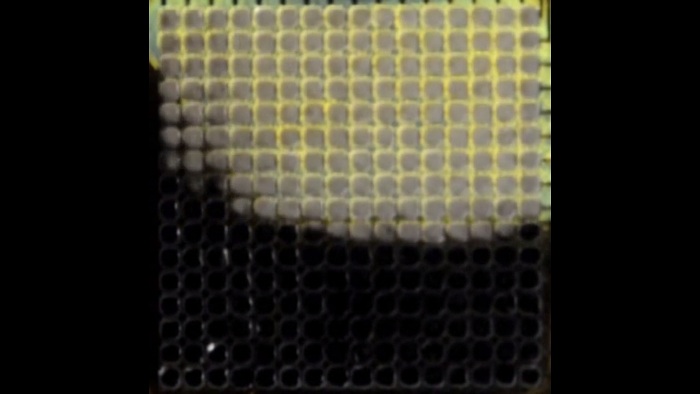New Camouflage Technology Copies a Cephalopod’s Natural Disguise Ability
![By Bernd (originally posted to Flickr as Mimic Octopus) [CC-BY-SA-2.0 (http://creativecommons.org/licenses/by-sa/2.0)], via Wikimedia Commons](https://techtheday.com/wp-content/uploads/2014/08/Octopus-camouflage.jpg)
By Bernd (originally posted to Flickr as Mimic Octopus) [CC-BY-SA-2.0 (http://creativecommons.org/licenses/by-sa/2.0)], via Wikimedia Commons
Octopuses are some of the most fascinating creatures of the sea. Their bodies are highly flexible that they can even fit into tiny holes dozens of times smaller than their normal body size. Even more interesting is their ability to disguise themselves in a variety of underwater scenes. Now, humans can make use of this impressive ability as researchers have developed an advanced camouflage technology inspired by octopuses.
In a paper published by the Proceedings of the National Academy of Science, a technology capable of mimicking the adaptive optoelectronic camouflage systems of cephalopod skins is introduced. This paper was made possible by a group of researchers from University of Houston, Northwestern University, University of Beijing, Nanjing University of Aeronautics and Astronautics, the University of Science and Technology of China, Brown University, and University of Illinois at Urbana-Champaign. The members of the research team include Cunjiang Yu, Yuhang Li, Xun Zhang, Xian Huang, Viktor Malyarchuk, Shuodao Wang, Yan Shi, Li Gao, Yewang Su, Yihui Zhang, Hangxun Xu, Roger Hanlon, Yonggang Huang, and John A. Rogers.
The original research for this technology was initiated by Roger Hanlon, a biologist from Brown University and the Marine Biological Laboratory at Woods Hole, Massachusetts. The research is now being funded by the United States Navy and has taken more than half a year to come up with the desired results.

Screenshot of the demo video for the new advanced camouflage technology (click on the image for the video link)
Optoelectronic Camouflage System
The research group created an optoelectronic camouflage system capable of detecting and controlling surrounding light. This system is comparable to the mechanisms involved in the disguising of octopuses, squids, and other mollusks.
In an interview with FoxNews.com, Yu noted that their intention in undertaking the research was to integrate natural principles in their artificial design by studying and copying, on a cellular level, the things that happen on the skin of a cephalopod. Cunjiang Yu is an assistant professor of mechanical engineering at the University of Houston.
On the other hand, in an interview with IEEE Sepctrum, John Rogers of the University of Illinois at Urbana-Champaign, said that they have put together the key elements necessary in duplicating the mechanisms involved in the natural camouflage system used by octopuses and other cephalopods.
How Does It Work?
This technology involves the use of light sensors, semiconductor actuators that react to heat and light, and heaters responsible for controlling the switching of colors. It’s pretty much the same as how an octopus or squid’s skin makes quick camouflaging possible. The technology does not take much time to analyze its environment to be able to implement the camouflage. It immediately does visual changes in response to its environment and does not require any human control.

Screenshot of the demo video for the new advanced camouflage technology (click on the image for the video link)
Applications
There are many applications of this new technology. Obviously, it’s a very important technology for the military. The research was funded by the Navy so it’s military application is a given. However, aside from the warfare or battlefield use, this camouflage technology can also be use for fancy cars and hobbyists. According to Cunjing Yu, it can also be used in biomedical research. Yu, in the same interview with FoxNews.com, also said that “people have shown excitement from various areas, from all over the scientific arena.” It may even find its way inside homes.
For John Rogers, industrial and consumer applications are also being explored. These applications include mood lighting that changes colors in response to UV light exposure. The research team presented a black-and-white demonstration of the technology but Rogers said that the technology also works with different colors. Yu supports this assertion, saying that the ultimate goal is to develop a technology that could respond to other colors. They are also planning to incorporate actuators or even cameras to enable a possibly better way of camouflaging objects.
![By Arimasen (Own work) [GFDL (http://www.gnu.org/copyleft/fdl.html) or CC-BY-SA-3.0-2.5-2.0-1.0 (http://creativecommons.org/licenses/by-sa/3.0)], via Wikimedia Commons](https://techtheday.com/wp-content/uploads/2014/05/invisibility-illustration1.jpg)
By Arimasen (Own work) [GFDL (http://www.gnu.org/copyleft/fdl.html) or CC-BY-SA-3.0-2.5-2.0-1.0 (http://creativecommons.org/licenses/by-sa/3.0)], via Wikimedia Commons
This camouflage technology is different from the invisibility cloak technologies we wrote about before. This one involves the use of pigments while the invisibility cloak mostly employs light redirection to trick the eyes, bending light in ways that create the illusion that something has become invisible. Both are interesting technologies although we are still yet to see an actual demonstration of their effectiveness and real life applications.